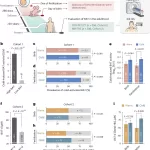The eligibility criteria for a nerve-stimulation treatment for obstructive sleep apnea has recently been extended to include patients with body mass indexes (BMIs) up to 40, opening up access to a broader range of individuals, including those classified as severely obese. However, a new study from Washington University School of Medicine in St. Louis suggests that the success of this treatment significantly diminishes as a patient’s weight increases above a healthy range.
Published in JAMA Otolaryngology-Head & Neck Surgery, the study underscores the importance of considering BMI when evaluating the effectiveness of hypoglossal nerve stimulation, a therapy designed to alleviate obstructive sleep apnea symptoms by stimulating the hypoglossal nerve, which controls tongue muscles.
Dr. Eric C. Landsness, senior author of the study, emphasized, “Our findings reveal that the more overweight a patient is, the less likely they are to benefit from nerve-stimulation treatment for sleep apnea. It’s crucial for physicians to provide patients with accurate information about their likelihood of success with this therapy, especially as eligibility criteria have expanded.”
Obstructive sleep apnea occurs when muscles in the mouth and throat relax during sleep, causing partial or complete blockage of airflow and oxygen supply. This condition can lead to serious health complications if left untreated, including excessive daytime sleepiness, headaches, strokes, and irregular heart rhythms.
Hypoglossal nerve stimulation offers an alternative to continuous positive airway pressure (CPAP) machines, which are commonly used to treat sleep apnea but can be uncomfortable and difficult to tolerate. The therapy involves the implantation of a small device that delivers electrical impulses to the hypoglossal nerve, preventing airway blockages during sleep.
While the therapy has shown promising results, the study found that the likelihood of treatment success decreases as BMI rises above 32. For each unit increase in BMI above 32, the odds of successful treatment decrease by approximately 17%.
“Body mass index is a critical factor in determining the effectiveness of hypoglossal nerve stimulation,” Dr. Landsness explained. “Patients with higher BMIs may need to consider alternative treatment options or weight management strategies to address their sleep apnea.”
The study underscores the importance of personalized treatment approaches for sleep apnea patients and highlights the need for further research to optimize outcomes for individuals across different weight ranges.
As hypoglossal nerve stimulation continues to gain popularity as a treatment for sleep apnea, understanding its limitations and considering individual patient factors will be essential in providing effective care for those affected by this sleep disorder.












